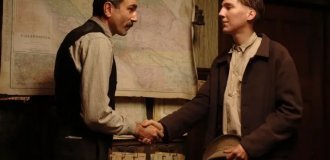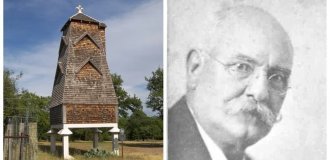“For the freshness of the tea!” How did the British obtain colonial goods in the 19th century? History of the Tea Races (4 photos)
Modern people are accustomed to seeing goods from all over the world on store shelves - fruits from Africa, vegetables from Asia, or, for example, tea from India. Most people don't wonder how these products ended up in the store. Modern preservation methods and advanced logistics have made possible what was simply unthinkable for people a hundred years ago. 
Tea clipper "Ariel". One of the most famous ships of the Tea Races. Painting from 1926
Once upon a time, huge sums of money were paid for fresh food brought from distant lands, and trade routes stretching across turbulent seas and oceans brought fabulous profits. And, of course, pirates, now covered in romantic glory, operated on such routes. So they tried to cover the path as quickly as possible, but not only because of the risk of being robbed. After all, cargo delivered on time, or even better ahead of schedule, increased significantly in price.
Due to their geographical location, the British were forced to live off maritime trade, which developed over centuries, eventually culminating in the British East India Company. It was she who controlled and monopolized trade routes from China to Europe, bringing spices and tea. However, in 1834 it lost its monopoly on trade with the countries of the east, and in 1849 the so-called “Navigation Act”, according to which only English ships could import goods into England, ceased to apply.
The journey from Asia to Europe was long and difficult, sometimes stretching for a whole year. During the voyage, perishable cargo became saturated with odors from the hold, began to deteriorate, or became completely unusable. All this meant that goods had to be delivered as quickly as possible, and this, in turn, marked the beginning of the “race for quality”.
In 1849, immediately after the abolition of the above-mentioned act, the American clipper Oriental arrived in England, delivering cargo from China to the Old World in 81 days, and the next year it repeated its journey again, but in 80 days. Realizing that their merchant fleet was inferior to the new American sailing ships, the British carried out one of the first documented industrial espionage operations. The hull of the American ship was measured, and the following year ships with similar characteristics, Stornaway and Criselight, left English shipyards. And in 1852, the Challenger, an almost complete copy of the Oriental, rolled off the stocks.
It is worth understanding the reason for such a stir. The fact is that at previous prices, a ton of tea was offered at 4 pounds sterling, while fresher tea, quickly delivered by the American Oriental, was already priced at 6 pounds sterling per ton. And for the British, this journey usually took just over a hundred days. In the press and society, such ships received the semi-official nickname “hounds of the ocean,” and their spontaneous races almost never stopped, until the opening of the Suez Canal, which significantly speeded up shipping and simplified it. 
The race between Taiping and Ariel as imagined by seascape artist Thomas Goldsworthy Dutton
At first, the lion's share of traffic came from American ships, which were chartered by local merchant associations to deliver goods, mainly tea from China and India. Then, with the growing popularity of this type of ships and the beginning of their construction at English shipyards, they began to be massively replaced by British-built ships. Since 1860, the British stopped chartering foreign ships and completely switched to their own ships. The concept of “Tea Races” originated a year earlier. In 1859, 11 tea clippers left China at the same time - this date is considered the beginning of the regular “Tea Races”.
The popularity of this event was extremely high - bets were placed on the ships like horses, they and their captains were written about in newspapers and discussed in local pubs. One of the most famous competitions took place in 1866. From May 26 to 28, 16 tea clippers, as they were already called then, left the port of Fuzhou in China and headed to England. On September 5, the clippers Taiping and Ariel entered the mouth of the Thames to the cheers of fans, with the first being only 10 minutes ahead of the second. This voyage received great attention in the media, and it was especially fueled by the behavior of the captain of the Taiping, who shared his first place award with the captain of the Ariel. The owner of the ship did the same, sharing the prize for first place with the owner of the Ariel. 
"Taiping" and "Ariel" inonke for first place. British artist Montagu Dawson
Such races continued for quite a long time, and the time that sailing ships spent on such a voyage became less and less. This era in the history of the sailing fleet is covered in the romanticism of sailing races and taking advantage of every minute for the sake of victory, which is followed by almost the entire country, as was the case with Taiping and Ariel. However, the dark side of such races is often overlooked. It was the tea clippers that transported huge amounts of opium from India to Chinese ports during their voyages towards China, which ultimately became one of the causes of the Second Opium War. 
"Cutty Sark". The most famous and only surviving three-masted sailing clipper ship of the 19th century, built in 1869
The end of the “tea race” was marked by the opening of the Suez Canal. Sailing ships could not overcome it without additional tricks, and steamships with their ever-improving mechanisms came to the fore. The “tea races” are a thing of the past, and the last takeoff of the sailing fleet in the form of the successors of the tea clippers - windjammers - will happen at the turn of the 19th and 20th centuries. Forced out of the sphere where quick transportation of small but expensive goods was required, sailing ships were forced to repurpose themselves into transportation of large volumes, where their efficiency and independence from coal reserves on board came in handy. But that's a completely different story.






























